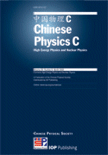
Chinese Physics C
Scope & Guideline
Connecting Global Minds in Physics Exploration
Introduction
Aims and Scopes
- Particle Physics:
The journal covers aspects of particle physics, including the study of fundamental particles, their interactions, and the theoretical frameworks such as the Standard Model and beyond. - Nuclear Physics:
Research on the structure, decay, and reactions of atomic nuclei, including topics like nuclear decay processes, neutron capture, and fission dynamics is a significant focus. - Astrophysics and Cosmology:
Papers exploring the physics of the universe, including dark matter, gravitational waves, and the cosmological implications of fundamental physics, are regularly published. - Quantum Field Theory and String Theory:
The journal features research on advanced theoretical concepts such as quantum field theories, string theory, and their applications in high-energy physics. - Computational Physics:
Numerical methods, simulations, and machine learning applications in physics research are increasingly important, reflecting the journal's commitment to computational approaches. - Experimental Techniques and Instrumentation:
Innovations in experimental techniques, detectors, and methodologies for studying high-energy processes in particle and nuclear physics are frequently highlighted.
Trending and Emerging
- Exotic Hadrons and Tetraquarks:
There is a growing interest in the study of exotic hadrons, including tetraquarks and pentaquarks, which suggests a deepening understanding of the strong force and quark interactions. - Gravitational Wave Astronomy:
Research related to gravitational waves and their astrophysical implications is on the rise, particularly following the successes of LIGO and other observatories. - Dark Matter and Dark Energy:
Studies addressing the nature of dark matter and dark energy are increasingly prominent, with researchers exploring new particles and theoretical frameworks. - Quantum Computing Applications in Physics:
The intersection of quantum computing and physics research is emerging as a significant trend, with studies focusing on leveraging computational advances to solve complex physical problems. - Machine Learning in Physics:
The application of machine learning techniques to analyze experimental data and optimize models is gaining traction, indicating a shift towards data-driven research methodologies. - High-Energy Collider Physics:
Research related to high-energy experiments at colliders such as the LHC continues to evolve, with new discoveries and analyses of rare processes becoming a focal point.
Declining or Waning
- Traditional Nuclear Models:
Research utilizing older nuclear models such as the liquid drop model or basic shell models has seen a decline, as newer, more sophisticated models gain traction. - Basic Particle Interaction Studies:
There is a noticeable reduction in publications focused solely on basic interaction studies without novel theoretical or experimental advancements. - Low-Energy Physics:
Topics centered on low-energy nuclear physics, which have historically been popular, are increasingly overshadowed by high-energy and astrophysical research. - Non-Exotic Baryon Studies:
Research focused on conventional baryons, without exploring exotic states or new physics, appears to be waning as interest shifts towards more complex systems.
Similar Journals

Physics of Particles and Nuclei Letters
Charting New Territories in Nuclear ResearchPhysics of Particles and Nuclei Letters, published by PLEIADES PUBLISHING INC, serves as a pivotal platform for the dissemination of cutting-edge research in the domains of particle and nuclear physics. With an ISSN of 1547-4771 and an E-ISSN of 1531-8567, this journal has been actively contributing to the scientific community since its inception in 2006 and continues to be influential, with a convergence period extending to 2024. While its open access options are limited, the journal is recognized for its rigorous peer-review process and commitment to quality, as reflected in its Scopus rankings across multiple categories, including a Q3 in Nuclear and High Energy Physics and Radiation in 2023. The journal is positioned to be a vital resource for researchers aiming to bridge theoretical understanding with practical applications in these highly specialized fields, fostering advances that resonate within atomic and molecular physics, radiology, and beyond. Its relevance continues to grow as the global scientific community seeks innovative solutions to complex problems in modern physics.

Physics
Connecting Scholars: Where Physics Meets InnovationPhysics, published by MDPI, is an open-access journal that commenced in 2019 and has quickly established itself as a significant contributor to the field of physics and astronomy. With a respectable impact factor and categorized in the Q2 quartile for 2023, this journal serves a broad spectrum of topics within the discipline, fostering innovative research and insights. As part of the MDPI portfolio, known for promoting high-quality, peer-reviewed research, Physics aims to provide a platform for scholars, professionals, and students to publish their findings and engage with contemporary debates in the field. The journal's accessibility, paired with its commitment to scientific excellence, ensures that research is readily available to a global audience, which is crucial for advancing knowledge and collaboration in physics. Located in the heart of Switzerland at ST ALBAN-ANLAGE 66, CH-4052 BASEL, the journal enjoys a position at the nexus of cutting-edge research and academia.
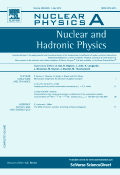
NUCLEAR PHYSICS A
Exploring the Depths of High Energy PhysicsNUCLEAR PHYSICS A, published by Elsevier, is a leading international journal dedicated to the fields of Nuclear and High Energy Physics. With an ISSN of 0375-9474 and E-ISSN 1873-1554, the journal has been pivotal in advancing research since its inception in 1967 and is set to continue influencing the discipline through 2025. It holds a commendable Q2 classification in the 2023 category of Nuclear and High Energy Physics, ranking 32nd out of 87 journals in its field according to Scopus, placing it in the 63rd percentile. NUCLEAR PHYSICS A provides valuable insights and disseminates cutting-edge research, aiding researchers, professionals, and students in their academic and practical pursuits. Though it does not currently offer open access, the journal remains a vital resource for those engaged in the exploration of nuclear phenomena and theoretical advancements in high-energy physics.
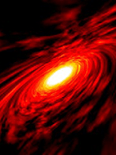
Annual Review of Nuclear and Particle Science
Pioneering Insights in High-Energy PhysicsAnnual Review of Nuclear and Particle Science is a prestigious journal published by Annual Reviews, focused on the fields of nuclear and high-energy physics. With an impressive impact factor that reflects its authority and influence—ranked Q1 in its category and holding a commendable Scopus rank of #2 out of 87, placing it in the 98th percentile—the journal serves as an essential resource for researchers, professionals, and advanced students alike. Covering pivotal developments and comprehensive reviews in nuclear and particle physics since its inception in 1978, this journal offers unparalleled insights into cutting-edge research and theoretical advancements. While it is not open access, the value of its scholarly content is evidenced by its rigorous peer-review process and its role in shaping contemporary discourse within the scientific community. With contributions from leading experts and a commitment to disseminating foundational and emerging theories, the Annual Review of Nuclear and Particle Science is indispensable for those seeking a deep understanding of the complexities in these dynamic fields.

INTERNATIONAL JOURNAL OF MODERN PHYSICS A
Driving innovation in astronomy, atomic, and nuclear physics.INTERNATIONAL JOURNAL OF MODERN PHYSICS A, published by WORLD SCIENTIFIC PUBL CO PTE LTD, stands as a pivotal platform in advancing the frontiers of research within the fields of Astronomy and Astrophysics, Atomic and Molecular Physics, and Nuclear and High Energy Physics. Established in 1989, this journal has systematically contributed to the scientific community, with a demonstrated impact as indicated by its Q2 category rankings across these critical disciplines in 2023. Researchers and professionals are encouraged to engage with its rigorous peer-reviewed content, fostering a deeper understanding of modern physics theories and experimental breakthroughs. Although the journal operates under a conventional access model, it remains a vital resource for those seeking to disseminate their findings and stay abreast of cutting-edge developments. With an emphasis on quality and breadth of research, the journal continues to attract submissions from leading physicists and scholars, enhancing its reputation as a key academic resource.
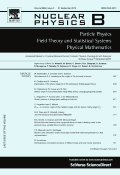
NUCLEAR PHYSICS B
Leading the Charge in Open Access Nuclear ResearchNUCLEAR PHYSICS B, published by Elsevier, stands at the forefront of research in the dynamic field of Nuclear and High Energy Physics. Established in 1967, this prestigious journal has developed a reputation for excellence, now positioned in the Q1 category according to its 2023 quartile rankings. With an impressive Scopus rank of #21 out of 87 in its category and a commendable 76th percentile, it serves as a vital resource for scholars investigating the underlying principles of nuclear interactions and particle physics. The journal transitioned to an Open Access model in 2014, ensuring that groundbreaking research is accessible to a global audience. Its commitment to quality and innovation makes NUCLEAR PHYSICS B an essential platform for researchers, professionals, and students aiming to stay at the cutting edge of discoveries in this expansive field, contributing to the scientific discourse for nearly six decades.
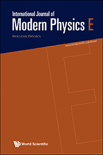
INTERNATIONAL JOURNAL OF MODERN PHYSICS E
Elevating Knowledge in Physics: A Global PerspectiveThe INTERNATIONAL JOURNAL OF MODERN PHYSICS E, published by WORLD SCIENTIFIC PUBL CO PTE LTD, serves as a distinctive platform for the dissemination of high-quality research in the fields of Nuclear and High Energy Physics, as well as Physics and Astronomy. With an ISSN of 0218-3013 and covering a timeline from 1996 to 2024, the journal has established itself within the academic community, achieving a respectable Q3 ranking in its respective categories for 2023, underscoring its commitment to advancing knowledge in modern physics. Although it operates without an open access model, the journal's curated content is accessible to a wide audience of researchers, professionals, and students engaged in cutting-edge physics. Set in Singapore, this journal not only contributes to scholarly discussions but also fosters a global collaboration among physicists, making it an invaluable resource for those seeking to deepen their understanding and contribute to ongoing dialogues in the scientific community.

EUROPEAN PHYSICAL JOURNAL C
Connecting Ideas Across Physics and Engineering DisciplinesEUROPEAN PHYSICAL JOURNAL C (EPJ C), published by SPRINGER, stands as a premier platform for innovative research in the domains of Physics and Engineering. With its Open Access policy established in 2014, EPJ C ensures that groundbreaking findings are readily available to the global scientific community, enhancing accessibility and collaboration. The journal, indexed in prestigious databases, boasts an impressive impact factor and ranks within the Q1 category for both Engineering and Physics and Astronomy, placing it among the top-tier journals in these fields. Celebrated for its rigorous peer-review process, EPJ C offers a wide-ranging scope encompassing various topics in particle physics, quantum field theory, and related interdisciplinary studies. Its consistent publication since 1991 has fostered a vibrant community of researchers dedicated to advancing knowledge and innovation in physics and engineering. Join the scholarly discussion and contribute to the cutting-edge research made possible through EPJ C's esteemed platform.

Particles
Fostering Collaboration in Astrophysics and Nuclear Research.Particles is an esteemed open access journal published by MDPI, focusing on the dynamic fields of astronomy, astrophysics, and nuclear and high energy physics. Since its inception in 2019, the journal has made significant strides in contributing to scholarly discourse, achieving a commendable ranking in the Q2 category for its relevant fields as of 2023. With a commitment to disseminating high-quality research, it offers unrestricted access to a global audience, fostering collaboration and knowledge exchange among researchers, professionals, and students. Located in Basel, Switzerland, Particles serves as a platform for innovative research and discussions that leverage the latest advances in physics. Its current Scopus rankings underscore its impact and relevance, with notable positions in various categories within Physics and Astronomy. Through its rigorous peer-review process and diverse publication options, Particles continues to carve a niche in the academic landscape, catering to a growing community engaged in pioneering exploration of fundamental particles and cosmic phenomena.

Journal of Cosmology and Astroparticle Physics
Connecting Researchers to the Heart of AstrophysicsThe Journal of Cosmology and Astroparticle Physics (ISSN: 1475-7516) is a premier publication in the field of astronomy and astrophysics, dedicated to advancing our understanding of the cosmos through innovative research. Published by IOP Publishing Ltd in the United Kingdom, this journal has established itself as a vital resource for researchers, professionals, and students alike, with an impressive Scopus rank of #11/90, placing it in the top 12% of its field. The journal aims to foster the dissemination of groundbreaking studies related to cosmology, dark energy, particle physics, and the universe's fundamental structure, making it a key player in shaping contemporary astrophysics discourse. With a Category Quartile of Q2 as of 2023, it continues to attract high-quality contributions that enhance scholarly dialogue. As an accessible platform, it engages a diverse audience interested in the frontiers of astrophysical research, encouraging collaboration and knowledge sharing among the global scientific community.